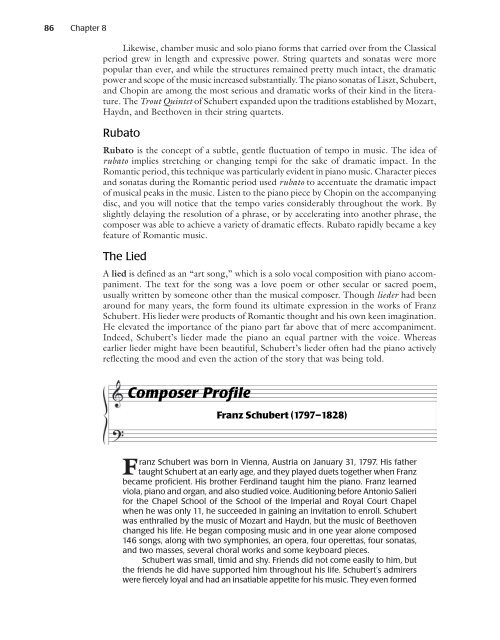Composer Profile - Activefolio
Composer Profile - Activefolio
Composer Profile - Activefolio
Create successful ePaper yourself
Turn your PDF publications into a flip-book with our unique Google optimized e-Paper software.
86 Chapter 8<br />
Likewise, chamber music and solo piano forms that carried over from the Classical<br />
period grew in length and expressive power. String quartets and sonatas were more<br />
popular than ever, and while the structures remained pretty much intact, the dramatic<br />
power and scope of the music increased substantially. The piano sonatas of Liszt, Schubert,<br />
and Chopin are among the most serious and dramatic works of their kind in the literature.<br />
The Trout Quintet of Schubert expanded upon the traditions established by Mozart,<br />
Haydn, and Beethoven in their string quartets.<br />
Rubato<br />
Rubato is the concept of a subtle, gentle fluctuation of tempo in music. The idea of<br />
rubato implies stretching or changing tempi for the sake of dramatic impact. In the<br />
Romantic period, this technique was particularly evident in piano music. Character pieces<br />
and sonatas during the Romantic period used rubato to accentuate the dramatic impact<br />
of musical peaks in the music. Listen to the piano piece by Chopin on the accompanying<br />
disc, and you will notice that the tempo varies considerably throughout the work. By<br />
slightly delaying the resolution of a phrase, or by accelerating into another phrase, the<br />
composer was able to achieve a variety of dramatic effects. Rubato rapidly became a key<br />
feature of Romantic music.<br />
The Lied<br />
A lied is defined as an “art song,” which is a solo vocal composition with piano accompaniment.<br />
The text for the song was a love poem or other secular or sacred poem,<br />
usually written by someone other than the musical composer. Though lieder had been<br />
around for many years, the form found its ultimate expression in the works of Franz<br />
Schubert. His lieder were products of Romantic thought and his own keen imagination.<br />
He elevated the importance of the piano part far above that of mere accompaniment.<br />
Indeed, Schubert’s lieder made the piano an equal partner with the voice. Whereas<br />
earlier lieder might have been beautiful, Schubert’s lieder often had the piano actively<br />
reflecting the mood and even the action of the story that was being told.<br />
<strong>Composer</strong> <strong>Profile</strong><br />
Franz Schubert (1797–1828)<br />
F ranz Schubert was born in Vienna, Austria on January 31, 1797. His father<br />
taught Schubert at an early age, and they played duets together when Franz<br />
became proficient. His brother Ferdinand taught him the piano. Franz learned<br />
viola, piano and organ, and also studied voice. Auditioning before Antonio Salieri<br />
for the Chapel School of the School of the Imperial and Royal Court Chapel<br />
when he was only 11, he succeeded in gaining an invitation to enroll. Schubert<br />
was enthralled by the music of Mozart and Haydn, but the music of Beethoven<br />
changed his life. He began composing music and in one year alone composed<br />
146 songs, along with two symphonies, an opera, four operettas, four sonatas,<br />
and two masses, several choral works and some keyboard pieces.<br />
Schubert was small, timid and shy. Friends did not come easily to him, but<br />
the friends he did have supported him throughout his life. Schubert’s admirers<br />
were fiercely loyal and had an insatiable appetite for his music. They even formed



